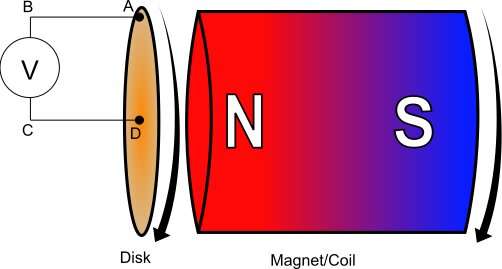Resolving 'Faraday's paradox': New experimental evidence on the influence of the test circuit

Unipolar induction is a specific form of induction that has caused much confusion among researchers and has been heavily debated in the literature, to the point that it has been deemed by some as paradoxical. After performing a new and rigorous experiment, clear evidence has been gathered that clarifies how the unipolar induction phenomenon occurs.
In 1831, when Michael Faraday first discovered that a voltage would be induced across the radius of a rotating conductor in the magnetic field of a bar magnet, he was startled by an apparent asymmetry of the problem. He realized that he could observe a voltage when the disk was spinning on its own and when disk and magnet were spinning together, but not when only the magnet was spinning. What followed has been almost two centuries of discussion among scientists and engineers, contesting whether the field is spinning with the magnet or remains stationary in space, and debating the applicability of the flux rule for this case—such discourse has earned unipolar induction the nickname, "Faraday's paradox."
In a recent research article in Scientific Reports, we assessed the existing views in the literature regarding this phenomenon and explored the various experiments that others carried out to explain it. In particular, one idea stood out to us to resolve the mystery, that is, the apparent paradox and asymmetry can be avoided if the experimental apparatus isn't viewed as just a disk and a magnet, but rather including the measurement device as part of the problem as well. Only then is a closed circuit obtained through which current can flow and the induced voltages can be measured (Fig. 1).
Now, with the circuit ABCDA, we can consider the apparatus to consist of three parts: magnet, disk (DA) and closing wire (BC). This allows eight possible cases of movement between the three parts to be considered; induction is only predicted if there is relative movement between the disk and closing wire as summarized in Table 1.

To test these predictions, we performed a series of experiments where the detection circuit could be rotated as well as the disk and magnet. We found that the induced voltages observed were in agreement with the predictions in Table 1 and induction is indeed determined by the relative motion between the disk and detection circuit. This new experimental evidence suggests that a complete discussion of the problem must include the closing wire. In doing so, much of the confusion surrounding unipolar induction can be avoided.
Nevertheless, some of the mysteries still remain. We have not been able to ascertain if the field is rotating with the magnet or not, and it remains unknown where the induction itself is seated between circuit parts DA and BC. The results can be equally well explained with a rotating field, a stationary field and a direct force transmission between the conductor charges. While new evidence demonstrates the key role of the measurement circuit, much of the debate regarding the underpinning mechanisms that explain this phenomenon will no doubt continue.
This story is part of Science X Dialog, where researchers can report findings from their published research articles. Visit this page for information about ScienceX Dialog and how to participate.
More information:
Christof Baumgärtel et al, Resolving the paradox of unipolar induction: new experimental evidence on the influence of the test circuit, Scientific Reports (2022). DOI: 10.1038/s41598-022-21155-x
Dr Simon Maher is currently an Associate Professor with the Department of Electrical Engineering and Electronics, University of Liverpool, U.K.
Dr Christof Baumgärtel recently completed his PhD studies at the Department of Electrical Engineering and Electronics, University of Liverpool, U.K. He is currently a post-doctoral research assistant in the same Department working on Next Generation Sensors for Aircraft Landing Gear.